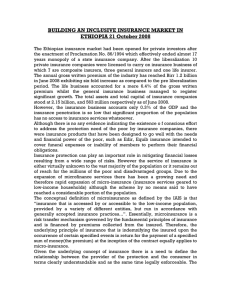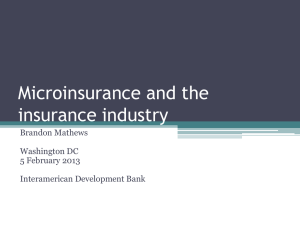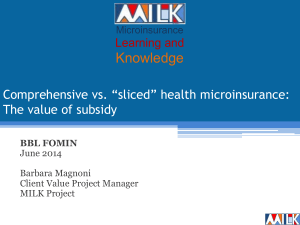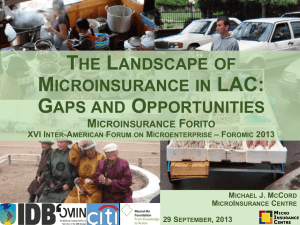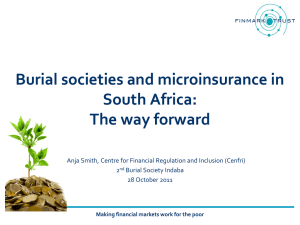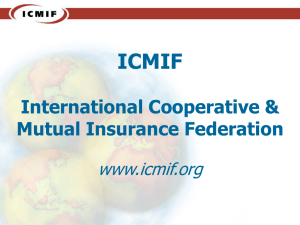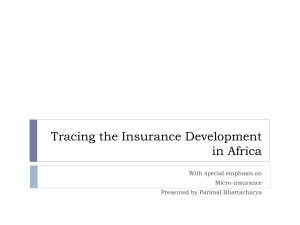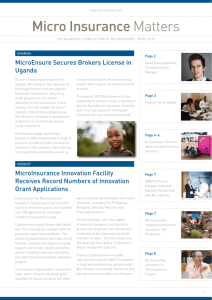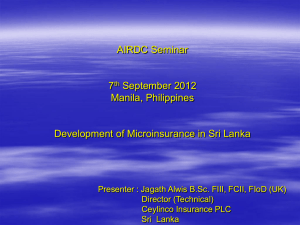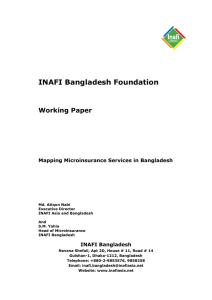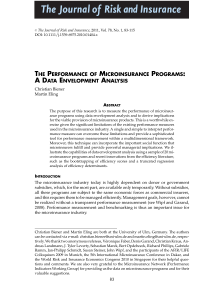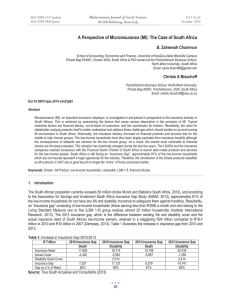Microinsurance is… - Risk Management & Insurance
advertisement
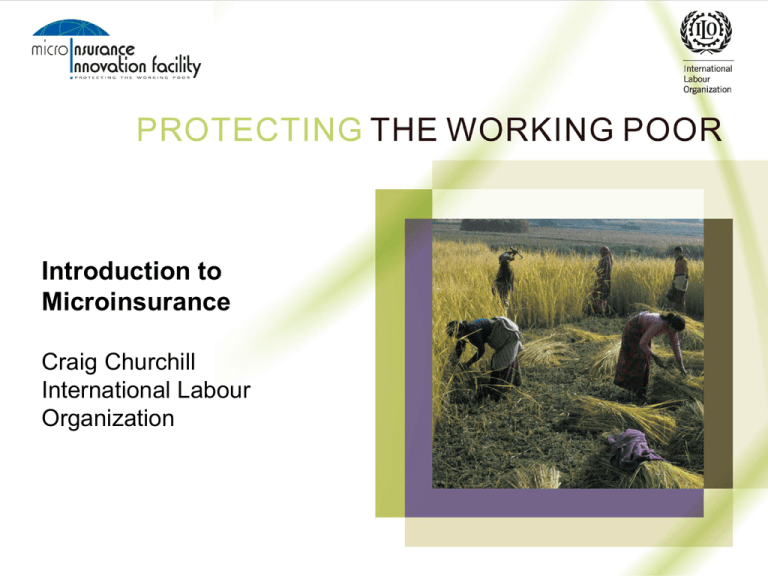
Introduction to Microinsurance Craig Churchill International Labour Organization Overview of Presentation 1. Introduction to inclusive insurance 2. Key differences between insurance and microinsurance 3. Overview of the Microinsurance Innovation Facility 4. Examples of microinsurance innovations 1) Introduction to inclusive insurance: Microinsurance ILO’s interest in microinsurance The ILO is concerned about the promotion of decent work: more and better jobs • The availability of social protection for workers and their families • The impact of financial polices on social justice, i.e. toward more inclusive financial markets This reflects the two most common perspectives on microinsurance… The microinsurance continuum Social Protection • Benefits are a human right (e.g. health, pension) • Contains a redistributive element New Market • 4 billion persons living on less than $2/day • Product and distribution innovations can make the poor a viable market for insurers Microinsurance is… “…a mechanism to protect low-income people against specific perils in exchange for regular premium payments proportionate to the likelihood and cost of the risk involved” Microinsurance is not… • Small insurance companies • Just another product offered by MFIs • Regular insurance products with smaller sums insured and premiums • Savings, credit, risk prevention Who is insured by whom? Formal insurance industry Informal insurance WEALTH Insurable, without access Uninsurable through market mechanisms POPULATION concerned Country What risks are the poor Priority risk about? Uganda Illness, death, disability, property loss, risk of loan Malawi Death, food insecurity, illness, education Philippines Death, old age, illness Viet Nam Illness, natural disaster, accidents, livestock disease Indonesia Illness, children’s education, poor harvest Lao P.D.R. Illness, livestock disease, death Georgia Illness, business losses, theft, death, retirement income Ukraine Illness, disability, theft Bolivia Illness, death, property loss (including crop loss in rural areas) Adapted from Cohen and Sebstad (2006) • • • • • • • Credit life Term life/Personal accident Savings life Property insurance Endowment life Health insurance Agriculture Degree of Success Degree of Difficulty Most common types of microinsurance products 2. Main differences between insurance and microinsurance Characteristics of the insurable poor • • • • Vulnerable to risks Often work in the informal economy Irregular cash flows Manage risks through myriad of informal means, including social networks • Limited education, literacy • Limited familiarity with formal insurance • May not trust insurance companies Illustrative differences between micro and conventional insurance Conventional Insurance Microinsurance Premium collected mostly from deductions in bank account Premium often collected in cash or associated with another financial transaction Regular premium payments Premiums should be designed to accommodate customers’ irregular cash flows Agents and brokers are primarily responsible for sales Distribution channel may manage the entire customer relationship, perhaps including premium collection and claims payment Market is largely familiar with insurance Market is largely unfamiliar with insurance Continued… Illustrative differences between micro and conventional insurance (cont.) Conventional Insurance Microinsurance Screening requirements may include a medical examination If there are any screening requirements, they would be limited to a declaration of good health Limited eligibility with standard exclusions Broadly inclusive, with few if any exclusions Sold by licensed intermediaries Often sold by unlicensed intermediaries; maybe underwritten by unregulated risk carrier Large sums insured Small sums insured Priced based on age/specific risk Community or group pricing Complex policy document Simple, easy to understand policy document Challenges for microinsurance • Developing sustainable products that meet the needs of the market • Reducing transactions costs (enhancing affordability) • Creating an enabling regulatory environment • Overcoming the market’s natural resistance and educational barriers • Building microinsurance infrastructure (e.g. actuaries, TA providers, data management systems) • Developing a microinsurance approach to claims • Distribution: getting products to market Delivery Channels Insurance companies Credit unions Banks On-line & ATM Labour unions Self-help groups Retailers MFIs NGOs Cooperatives Utility companies LowIncome People Smart cards Cell phones Employers Computer kiosks Service providers Link to existing transactions for efficiency 3) Microinsurance Innovation Facility Four Pillars of Activities Microinsurance Innovation Facility Innovation Grants Technical assistance Research Dissemination Innovation Grants • • • • Grants: $20,000 to $600,000 for 2-3 years Frequency: 5-10 issued every 6 months Purpose: To test new products, models or approaches to consumer education Organizations eligible include insurance companies, semi-formal microinsurers, employers’ associations, labour unions, cooperatives and other people’s organizations, and other distribution channels Africa Latin America/ Caribbean Asia Institutional models SCC/CIC/NHIF (Kenya) Health FINCA/Microcare (Uganda) UMSGF (Guinea) Calcutta Kids (India) VimoSEWA (India) Property / Agriculture Hollard (South Africa) Planet Guarantee (Mali) People Mutuals (India) DID/SICL (Sri Lanka) Life /Accident UAB (Burkina Faso) Other La Positiva (Peru) AMUCCS (Mexico) Seguros Argos (Mexico) AIC (Haiti) PICC (China) ICICI Prudential (India) Max New York Life (India) Guy Carpenter (Latin America) CIRM (India) Research • • Key themes: – Demand – Supply – Client value and impact Methodologies: – Action research with innovation grantees – Small research grants – Thematic studies – Impact studies 4) Examples of innovations: - delivery channels - products Partnerships between insurers and distribution agents like cooperatives and MFIs • AIG and Ugandan MFIs • Zurich Venezuela and BanGente • Equidad and MFIs/Coops (Colombia) Partnerships with utility companies or service providers • La Positiva (Peru) and water associations • MAPFRE Seguros and CODENSA, Colombia • Philam Life, and cell phones (Philippines) Cooperative Insurance Company, Kenya • Developing Bima ya Jamii: “Basket” product covering life, disability and the National Health Insurance Fund (NHIF) coverage • Selling through MFIs, SACCOs and other cooperatives • Emphasizing training and consumer education for distribution channels and their members • Collaborating with Swedish Cooperative Centre, NHIF, and Folksam Insurance (Sweden) Hollard, South Africa • Providing homeowners and content coverage for lowincome households • Selling through non-traditional distributors: retail shops, mobile phone air time vendors • Testing inexpensive claims assessment strategies • Providing replacement materials instead of cash payouts • Learning about the demand for voluntary asset cover (most microinsurance is mandatory) Insurance companies that target the low-income market through retailers • Colseguros and Carrefour, Colombia • Max New York Life, India Union des Assurances du Burkina Vie (UAB) • Targeting informal sector entrepreneurs (e.g. market vendors) • Distributing Cauri d’or, based on a contractual savings scheme that includes life and disability coverage • Collecting clients’ contributions daily (as low as 150 francs CFA or 0.35 USD per day) • Testing smart cards and collectors with hand-held terminals to improve efficiency and reduce fraud Community-based schemes that pool funds, carry risk and manage a relationship with a healthcare provider (e.g. L’Union Technique de la Mutualité Malienne, Mali) Products Health insurance • Product for which there is the greatest demand • Often coverage limited to hospitalization, or even a daily payment not linked to health care costs • Straddles the gray area between social protection and commercial insurance • Difficult to offer because: – Additional player involved (health care provider) – Prone to moral hazard, fraud, adverse selection and over-usage problems – Skewed incentives – On a commercial basis, can only be made affordable to the poor by severely limiting benefits Products Agriculture insurance • No evidence yet of sustainable agriculture insurance (for the poor), all heavily government subsidized • Prone to moral hazard problems: farmers were less likely to pursue sound practices • Recent innovations such as rain-fall index insurance show some potential to make agriculture insurance measurable, objective and viable...although most experiences are only in the pilot stage Products Conclusion: Key product issues 1. 2. 3. 4. 5. 6. 7. 8. Piggyback or standalone Mandatory or voluntary Group or individual Long or short term Inclusive vs. cherry picking risks Premium collection timing and mechanism Fast claims payments KISS
